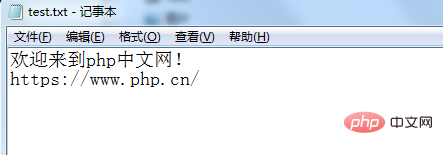Home > Article > Backend Development > PHP file operation: reading files character by character
In the previous article "What is the file mode of php file operation? How to change file mode? ", we briefly understood the file mode and introduced the method of using the chmod() function to change the file mode. In this article, we will introduce to you a method of reading files - reading files character by character, let's learn together!
File reading and writing is one of the most basic operations in program development. In actual development, it is often necessary to read data from files or write data to files; therefore, it is very important to master file reading and writing operations. of. Today we will first learn about reading a character from a file and how to read the file character by character. In subsequent articles we will slowly introduce other operations.
Okay, let’s get to the topic!
We have a text file named "test.txt", the content of which is:

How to read the contents of the file character by character and output? Let’s go directly to the code and take a look:
<?php
header("Content-Type: text/html;charset=utf-8"); //设置字符编码
$handle = fopen('./test.txt', 'r'); //打开文件
if (!$handle) { //判断文件是否打开成功
echo '文件打开失败!';
}
while (false !== ($char = fgetc($handle))) { //循环读取文件内容
echo $char;
}
fclose($handle); //关闭文件
?> Output result:
Isn’t it very simple! Here is a brief analysis of several key functions:
fopen() Function: Open a file or URL in the specified file mode. If the opening is successful, the file pointer resource is returned; if the opening fails, FALSE is returned. For example, "fopen('./test.txt', 'r')" opens the test.txt file in read-only mode.
This function requires two parameters: $filename and $mode. $filename specifies the file or URL to be opened; and $mode is used to set the file opening method (file mode).
$mode settable values:
r: read-only mode, open the file in read-only mode (the file must exists); the operation starts from the beginning of the file.
r: Read and write mode, open the file in read and write mode (the file must exist); start the operation from the beginning of the file.
w: Write-only mode, open the file in write-only mode. The file's contents are opened and cleared; if the file does not exist, a new file is created.
w: Read and write mode, open the file in read and write mode. The difference from r mode is that this mode will open and clear the contents of the file; if the file does not exist, a new file will be created.
a: Append mode, writes content to the end of the file. If the file does not exist, a new file is created.
a: Read/append mode, starting from the end of the file, you can write content to the end of the file. If the file does not exist, a new file is created.
x: Write-only mode, creates a new file and opens it for writing; returns FALSE and an error if the file already exists.
x: Read-write mode, creates a new file and opens it in read-write mode; if the file already exists, returns FALSE and an error.
c: Write-only mode. Opens a file for writing, or creates the file if it does not exist. If the file exists, the file contents are not cleared and the file pointer is pointed to the file header.
c: Read and write mode. Opens a file for reading and writing, or creates the file if it does not exist. If the file exists, the file contents are not cleared and the file pointer is pointed to the file header.
fgetc()Function: You can return a string containing one character from the open file. Returns FALSE when EOF is reached.
fclose()Function: You can close the open file, return TRUE if successful, return FALSE if failed.
After operating the file, remember to use the fclose() function to close the file!
Okay, that’s all. If you want to know anything else, you can click this. → →PHP file basic operations
The above is the detailed content of PHP file operation: reading files character by character. For more information, please follow other related articles on the PHP Chinese website!